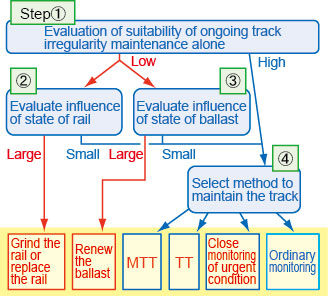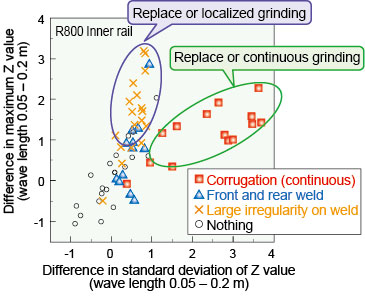8.Track maintenance work selection model aimed at minimizing cost and risk
- In order to minimize risks and cost of track maintenance work a model has been designed for selecting suitable work to be carried out based on an evaluation of the state of materials and track irregularity from past measured data.
- The present model makes it possible to reduce both maintenance costs and risk of derailments accident.
Rail surface roughness and ballast deterioration are among the types of age-related material damage found on ballasted track. This type of damage requires more frequent work to correct track irregularities and also increases risk of derailments or disruptions to traffic. Appropriate measures (track work) must be chosen to repair such damage. However, replacing materials is more costly than correcting track irregularity. It is therefore important to time replacement of materials carefully bearing in mind efficiency, in order to keep overall maintenance costs down whilst avoiding risk. Consequently a model was designed on the basis of past track data on track irregularity and axle box vibration acceleration in order to assess the state of the track and plan the appropriate work to be performed (Fig.1).
It is almost impossible to maintain the track to the required standard by simple correction of track irregularity alone. The present model therefore evaluates the influence of the state of the rail and ballast by section on deterioration of track irregularity. This in turn helps to determine where over the long term it is more cost effective to actually replace the materials.
The state of the rail is evaluated according to axle box vibration acceleration and ballast according to data on improvements at the time of previous track irregularity correction work.
Following the result of this evaluation, the appropriate work and monitoring plan can be selected and drawn up, such as multiple tie tamper (MTT), tie tamper (TT) track irregularity maintenance, grinding or replacement of the rail and ballast renewal.
Verification of the model was conducted with real data, and confirmation was obtained that the proposed type of work correlated with the actual state of the track (Fig.2). The present method means that decisions will no longer depend solely on experience and visual inspections, it should also ensure that work is carried out on sections in order of priority and finally should improve overall safety and cost effectiveness of maintenance work.

Fig.1 Maintenance work selection model
Fig.2 Assessment of the state of the rail according to
difference in left-right axle box vibration acceleration
and suggested work as a consequence